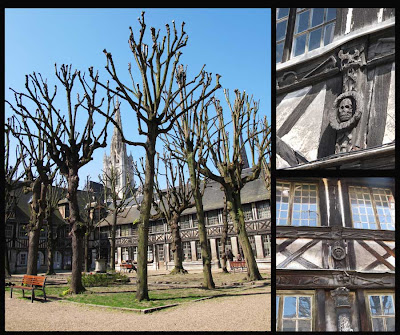Before coming to Rouen, I knew three exactly things about the city:
- Joan of Arc was flambeed here,
- Monet was so fascinated by the changing light on the cathedral he painted it many (i.e. 30) times, and
- Julia Child fell in love with French cuisine at a restaurant here, thanks to the film Julie and Julia (very charming if you haven't seen it)
Note: In addition to our dinner, the Crown has witnessed the burning of Joan of Arc (1431), the Black Death (1348), countless wars and celebrations, all the while serving the famous, the infamous, and the rest of us for nearly 700 years. Ironically, one of the outbreaks of the Black Death in Rouen may have started around May 7 (our anniversary), 1348 (NOT our date!) according to this book.
 The interior is suprisingly unstuffy. The ceiling is low, with heavy dark beams, as you might expect.
The interior is suprisingly unstuffy. The ceiling is low, with heavy dark beams, as you might expect. A silver coffee urn shaped torture device, for making the famous Canard à la Rouennaise*, is prominently featured. There was trap door under my chair. What's under there? ...
A silver coffee urn shaped torture device, for making the famous Canard à la Rouennaise*, is prominently featured. There was trap door under my chair. What's under there? ...This is old school fine dining; ladies get a menu without prices.
Having had a full French dinner before, Dave opted for lighter fare.
- the sweetest cantalope imagineable with a salty proscuttio
- seared halibut in a light, fragrant curry sauce over beans
- a very fluffy Grand Marnier souffle
- meltingly tender duck liver with fresh figs

- delicate, lemony dover sole meunière
- cheeses selected from the 45 or so options available (no kidding-the tray was sagging under the weight of all the cheeses to choose from!)
For your further reading:
Top 10 culinary highlights of Normandy
*Canard à la Rouennaise:
- Strangle 1 live, young duck (you'll need the blood for the sauce later...)
- Remove the feathers and entrails, leaving the liver and gizzards.
- Roast lightly.
- Remove the still rare breast and thighs.
- Put the rest of the carcass in a presse à canard (duck press) and squeeze out the blood and juices.
- Reduce the blood, and blend with the liver to make a sauce.






















